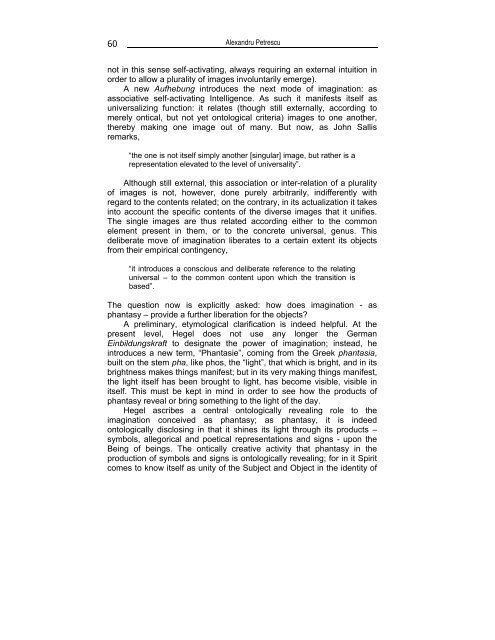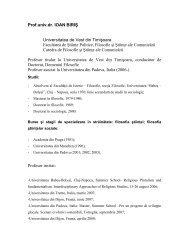analele universităţii de vest din timişoara annales universitatis ...
analele universităţii de vest din timişoara annales universitatis ...
analele universităţii de vest din timişoara annales universitatis ...
You also want an ePaper? Increase the reach of your titles
YUMPU automatically turns print PDFs into web optimized ePapers that Google loves.
60<br />
Alexandru Petrescu<br />
not in this sense self-activating, always requiring an external intuition in<br />
or<strong>de</strong>r to allow a plurality of images involuntarily emerge).<br />
A new Aufhebung introduces the next mo<strong>de</strong> of imagination: as<br />
associative self-activating Intelligence. As such it manifests itself as<br />
universalizing function: it relates (though still externally, accor<strong>din</strong>g to<br />
merely ontical, but not yet ontological criteria) images to one another,<br />
thereby making one image out of many. But now, as John Sallis<br />
remarks,<br />
“the one is not itself simply another [singular] image, but rather is a<br />
representation elevated to the level of universality”.<br />
Although still external, this association or inter-relation of a plurality<br />
of images is not, however, done purely arbitrarily, indifferently with<br />
regard to the contents related; on the contrary, in its actualization it takes<br />
into account the specific contents of the diverse images that it unifies.<br />
The single images are thus related accor<strong>din</strong>g either to the common<br />
element present in them, or to the concrete universal, genus. This<br />
<strong>de</strong>liberate move of imagination liberates to a certain extent its objects<br />
from their empirical contingency,<br />
“it introduces a conscious and <strong>de</strong>liberate reference to the relating<br />
universal – to the common content upon which the transition is<br />
based”.<br />
The question now is explicitly asked: how does imagination - as<br />
phantasy – provi<strong>de</strong> a further liberation for the objects?<br />
A preliminary, etymological clarification is in<strong>de</strong>ed helpful. At the<br />
present level, Hegel does not use any longer the German<br />
Einbildungskraft to <strong>de</strong>signate the power of imagination; instead, he<br />
introduces a new term, “Phantasie”, coming from the Greek phantasia,<br />
built on the stem pha, like phos, the “light”, that which is bright, and in its<br />
brightness makes things manifest; but in its very making things manifest,<br />
the light itself has been brought to light, has become visible, visible in<br />
itself. This must be kept in mind in or<strong>de</strong>r to see how the products of<br />
phantasy reveal or bring something to the light of the day.<br />
Hegel ascribes a central ontologically revealing role to the<br />
imagination conceived as phantasy; as phantasy, it is in<strong>de</strong>ed<br />
ontologically disclosing in that it shines its light through its products –<br />
symbols, allegorical and poetical representations and signs - upon the<br />
Being of beings. The ontically creative activity that phantasy in the<br />
production of symbols and signs is ontologically revealing; for in it Spirit<br />
comes to know itself as unity of the Subject and Object in the i<strong>de</strong>ntity of




